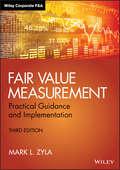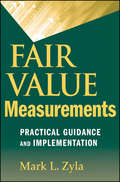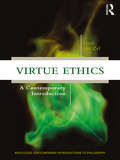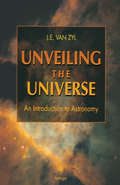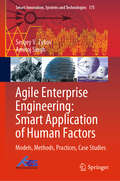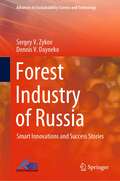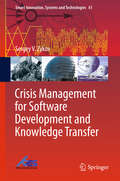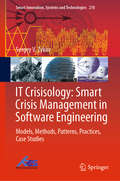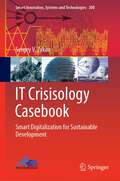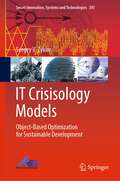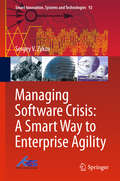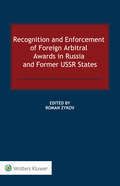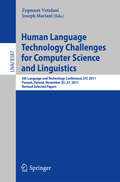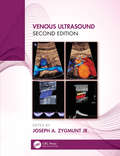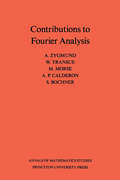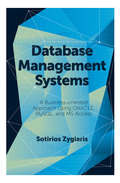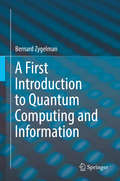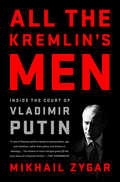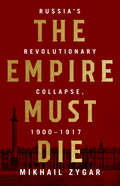- Table View
- List View
Fair Value Measurement: Practical Guidance and Implementation (Wiley Corporate F&A)
by Mark L. ZylaGet up to date on the latest FASB, SEC, and AICPA guidelines and best practices Fair Value Measurement provides hands-on guidance and the latest best practices for measuring fair value in financial reporting. The Financial Accounting Standards Board (FASB), the U.S. Securities and Exchange Commission (SEC), and the American Institute of CPAs (AICPA) have all updated their guidelines for practitioners, and this book details the changes from a practical perspective. This new third edition includes a discussion on Private Company Council accounting alternatives for business combinations and impairment testing, with a detailed example of the Market Participant Acquisition Premium (MPAP), including European and Asian examples and expanded discussion of IFRS. Ancillary materials including end-of-chapter questions and answers, PowerPoint slides, and a test bank help you quickly grasp the concepts presented, making this book ideal for both classroom and practitioner use. Fair value measurement guidelines continue to evolve, and this comprehensive reference provides a valuable, up-to-date resource for preparers, auditors, and valuation specialists. Adopt the best practices for implementing the FASB's Topic 820 Learn the latest reporting requirements for fair value measurements Understand accounting alternatives for business combinations Examine the details of MPAP in Europe and Asia Applying fair value measurements to financial statements requires a move away from rules-based standards and toward application of professional judgment. This controversial shift has led to a reliance on valuation specialists, who face their own challenges in applying Topic 820 amidst an economic downturn and recovery, leading to an ever evolving set of best practices. Practitioners must stay up to date, and be aware of the changes as they occur. Fair Value Measurement provides the most recent information and a practical approach to this area of financial reporting.
Fair Value Measurement: Practical Guidance and Implementation (Wiley Corporate F&A #634)
by Mark L. ZylaGet up to date on the latest FASB, SEC, and AICPA guidelines and best practices Fair Value Measurement provides hands-on guidance and the latest best practices for measuring fair value in financial reporting. The Financial Accounting Standards Board (FASB), the U.S. Securities and Exchange Commission (SEC), and the American Institute of CPAs (AICPA) have all updated their guidelines for practitioners, and this book details the changes from a practical perspective. This new third edition includes a discussion on Private Company Council accounting alternatives for business combinations and impairment testing, with a detailed example of the Market Participant Acquisition Premium (MPAP), including European and Asian examples and expanded discussion of IFRS. Ancillary materials including end-of-chapter questions and answers, PowerPoint slides, and a test bank help you quickly grasp the concepts presented, making this book ideal for both classroom and practitioner use. Fair value measurement guidelines continue to evolve, and this comprehensive reference provides a valuable, up-to-date resource for preparers, auditors, and valuation specialists. Adopt the best practices for implementing the FASB's Topic 820 Learn the latest reporting requirements for fair value measurements Understand accounting alternatives for business combinations Examine the details of MPAP in Europe and Asia Applying fair value measurements to financial statements requires a move away from rules-based standards and toward application of professional judgment. This controversial shift has led to a reliance on valuation specialists, who face their own challenges in applying Topic 820 amidst an economic downturn and recovery, leading to an ever evolving set of best practices. Practitioners must stay up to date, and be aware of the changes as they occur. Fair Value Measurement provides the most recent information and a practical approach to this area of financial reporting.
Fair Value Measurements: Practical Guidance and Implementation (Wiley Corporate F&a Ser. #634)
by Mark L. ZylaA hands-on volume for financial executives with guidance on the fair value measurement process In today's dynamic and volatile markets, whether buying or selling, what corporate officers need to know is the worth of an asset today, a task that for many has become complex and at times confusing. Fair Value Measurements: Practical Guidance and Implementation demystifies this topic, offering you a nuts-and-bolts guide of the most recent developments in preparing financial statements using fair value measurements. This straightforward book covers the best practices on measuring fair value in a business combination and how to subsequently test the value of these assets for impairment. Filters complicated insider concepts into easy-to-understand information on the valuation specialist's function Discusses the many new FASB pronouncements involving fair value Instantly familiarizes you on the ins and outs of fair value financial disclosure Well-written, conversational in tone, and filled with valuable insights, Fair Value Measurements: Practical Guidance and Implementation lifts the veil of confusion from the substantial and growing requirements for fair value disclosures.
Fair Value Measurements: Practical Guidance and Implementation
by Mark L. ZylaA hands-on volume for financial executives with guidance on the fair value measurement process In today's dynamic and volatile markets, whether buying or selling, what corporate officers need to know is the worth of an asset today, a task that for many has become complex and at times confusing. Fair Value Measurements: Practical Guidance and Implementation demystifies this topic, offering you a nuts-and-bolts guide of the most recent developments in preparing financial statements using fair value measurements. This straightforward book covers the best practices on measuring fair value in a business combination and how to subsequently test the value of these assets for impairment. Filters complicated insider concepts into easy-to-understand information on the valuation specialist's function Discusses the many new FASB pronouncements involving fair value Instantly familiarizes you on the ins and outs of fair value financial disclosure Well-written, conversational in tone, and filled with valuable insights, Fair Value Measurements: Practical Guidance and Implementation lifts the veil of confusion from the substantial and growing requirements for fair value disclosures.
How to Win at Shopping: 297 Insider Secrets for Getting the Style You Want at the Price You Want to Pay
by David Zyla Eila MellA book worth its weight in gold—or what one charges on a gold card. Written by two fashion experts with deep experience in fashion shopping and styling, How to Win at Shopping is perfect for the woman who loves to shop—there is priceless information on every page. And perfect for the woman who hates to shop—here&’s the game plan to make it work. And for both, hundreds of ways to save money, time, and aggravation. Page after page is filled with knowledgeable insider tips, the hows and whys of shopping smart: Always beware of prices in carpeted areas of a store. Three-quarter sleeves are always flattering. Sometimes, for certain items like T-shirts or knits, it makes sense to shop in the boys&’ department. For shoes, the best toe shape will always match your best neckline. Never shop in a hurry. When approaching a rack of clothing, always start with color. Always sit down when trying on clothing. There are style basics, like how to find the perfect pair of jeans. Money-saving tips, like why never to open a store credit card. Shopping rules, like leave your jewelry at home when shopping. Plus tips for shopping online, in thrift stores, and around the holidays. And throughout, separate lists, like the 15 secrets of finding clothes that make you look ten pounds thinner; the seven things a tailor can do—and six things a tailor can&’t; and the top ten wardrobe staples.
The End of European Security Institutions?: The EU’s Common Foreign and Security Policy and NATO After Brexit (SpringerBriefs in Political Science)
by Benjamin ZylaThis book discusses Brexit’s implications for the two most important security institutions in Europe, the EU’s Common Foreign and Security Policy (CFSP) and the North Atlantic Treaty Organization (NATO). While Brexit is still unfolding, this book asks what it would mean for the future embedding of the UK into CFSP and NATO, as well as how it will most likely affect the inner mechanics of the transatlantic alliance (NATO) and CFSP in particular, in the years to come. The book is divided into two parts. Part I provides a historical overview of the evolution of the relationships between the UK and NATO and the EU, respectively. Part II discusses the geopolitical contexts and potential impacts of Brexit, focusing on the contemporary security environment, as well as the options that the EU has, in the event an agreement is concluded. Using both predictive and normative arguments, this book provides likely scenarios for an event that continues to be a source of much uncertainty for the global community.Making an important contribution to one of the most important policy debates in international security affairs today, this book is of interest to students and researchers of international security affairs, European politics, and global governance as well as policymakers and practitioners working on the Brexit file.
Virtue Ethics: A Contemporary Introduction (Routledge Contemporary Introductions to Philosophy)
by Liezl Van ZylThis volume provides a clear and accessible overview of central concepts, positions, and arguments in virtue ethics today. While it focuses primarily on Aristotelian virtue ethics, it also includes discussion of alternative forms of virtue ethics (sentimentalism and pluralism) and competing normative theories (consequentialism and deontology). The first six chapters are organized around central questions in normative ethics that are of particular concern to virtue ethicists and their critics: What is virtue ethics? What makes a trait a virtue? Is there a link between virtue and happiness? What is involved in being well-motivated? What is practical wisdom? What makes an action right? The last four chapters focus on important challenges or objections to virtue ethics: Can virtue ethics be applied to particular moral problems? Does virtue ethics ultimately rely on moral principles? Can it withstand the situationist critique? What are the prospects for an environmental virtue ethics? ?
Unveiling the Universe: An Introduction to Astronomy
by J.E. van ZylA wealth of material on practically every aspect of astronomy, beginning from the first principles. It is quite unique in providing a level of scientific accuracy and detail to be found in no other introductory book, including coverage of instruments, theory, observation, space exploration and cosmology. Encyclopaedic in its breadth, the book still contains in-depth explanations of the underlying theories. The illustrations - many of them colour photographs - animate the text, itself so clear and concise that it will fascinate readers of every discipline.Winner of the Rapportryers Prize for "most meritorious popular science book".
Agile Enterprise Engineering: Models, Methods, Practices, Case Studies (Smart Innovation, Systems and Technologies #175)
by Sergey V. Zykov Amitoj SinghThis concise book provides a survival toolkit for efficient, large-scale software development. Discussing a multi-contextual research framework that aims to harness human-related factors in order to improve flexibility, it includes a carefully selected blend of models, methods, practices, and case studies. To investigate mission-critical communication aspects in system engineering, it also examines diverse, i.e. cross-cultural and multinational, environments. This book helps students better organize their knowledge bases, and presents conceptual frameworks, handy practices and case-based examples of agile development in diverse environments. Together with the authors’ previous books, "Crisis Management for Software Development and Knowledge Transfer" (2016) and "Managing Software Crisis: A Smart Way to Enterprise Agility" (2018), it constitutes a comprehensive reference resource adds value to this book.
Forest Industry of Russia: Smart Innovations and Success Stories (Advances in Sustainability Science and Technology)
by Sergey V. Zykov Dennis V. DaynekoThis book focuses on crisis management in forest industry of Russia. It is about the present, and the future, with a short retrospective about the past of the forest industry in Russia. It includes forecasting too and description of some of the best practices of developed countries to be implemented in Russia to overcome the crisis. The main theme of the book is smart innovations and innovative activities introduced and also those which are required in the forest industry of Russia. The book considers the effectiveness of innovations and institutional changes in the forest industry, which are an important direction of innovation activities required all together with technological and economic breakthrough with ecological aspects in priority. The necessity to implement the modern innovation system in the forest industry based on institutional changes is substantiated and thoroughly explained with successful examples of ongoing and future up-to-date smart innovations. The development of the forest innovation system is suggested for sustainable forest industry management; the key components of which are technological, product, institutional, and ecological innovations, as well as, innovative entrepreneurship. Realization of the innovation system for technological and intellectual improvement requires good scientific and personnel provision, anticipation of markets and tendencies of development for some decades ahead. The implied advanced technologies in the forest industry also include IT-, nano-, and biotechnologies. The success stories of the leading Russian and international companies in the forest industry of Russia are studied attentively in the book. The book presents a profound methodical and theoretical substantiation for the further implementation of the smart innovations and of the successful experience of the industry leading companies.
Crisis Management for Software Development and Knowledge Transfer (Smart Innovation, Systems and Technologies #61)
by Sergey V. ZykovThis well structured book discusses lifecycle optimization of software projects for crisis management by means of software engineering methods and tools. Its outcomes are based on lessons learned from the software engineering crisis which started in the 1960s. The book presents a systematic approach to overcome the crisis in software engineering depends which not only depends on technology-related but also on human-related factors. It proposes an adaptive methodology for software product development, which optimizes the software product lifecycle in order to avoid “local” crises of software production. The general lifecycle pattern and its stages are discussed, and their impact on the time and budget of the software product development is analyzed. The book identifies key advantages and disadvantages for various models selected and concludes that there is no “silver bullet”, or universal model, which suits all software products equally well. It approaches software architecture in terms of process, data and system perspectives and proposes an incremental methodology for crisis-agile development of large-scale, distributed heterogeneous applications. The book introduces a number of specialized approaches which are widely used in industry but are often ignored in general writings because of their vendor-specificity. In doing so, the book builds a helpful bridge from academic conceptions of software engineering to the world of software engineering practice. With its systematic coverage of different software engineering methodologies and the presented rich systems engineering examples the book will be beneficial for a broader audience.
IT Crisisology: Models, Methods, Patterns, Practices, Case Studies (Smart Innovation, Systems and Technologies #210)
by Sergey V. ZykovThis book focuses on crisis management in software development which includes forecasting, responding and adaptive engineering models, methods, patterns and practices. It helps the stakeholders in understanding and identifying the key technology, business and human factors that may result in a software production crisis. These factors are particularly important for the enterprise-scale applications, typically considered very complex in managerial and technological aspects and therefore, specifically addressed by the discipline of software engineering. Therefore, this book throws light on the crisis responsive, resilient methodologies and practices; therewith, it also focuses on their evolutionary changes and the resulting benefits.
IT Crisisology Casebook: Smart Digitalization for Sustainable Development (Smart Innovation, Systems and Technologies #300)
by Sergey V. ZykovThe book focuses on the real-world case-based crisis management in digital product development. This includes forecasting, responding, and agile engineering/management methods, patterns, and practices for sustainable development. This book introduces a set of case studies for sustainability in management as a blend, the components of which have been carefully selected from a few domains adjacent to digital production such as IT-intensive operation, human resource management, and knowledge engineering, to name a few. The key ingredients of this crisis management framework include information management, tradeoff optimization, agile product development, and knowledge transfer. The case studies this book features will help the stakeholders in understanding and identifying the key technology, business, and human factors that may likely result in a digital production crisis, i.e., critically affect the organization outcomes in terms of successful digitalization and sustainable development. These factors are particularly important for the large-scale applications, typically considered very complex in managerial and technological aspects, and, therefore, specifically addressed by the discipline of IT crisisology.
IT Crisisology Models: Object-Based Optimization for Sustainable Development (Smart Innovation, Systems and Technologies #381)
by Sergey V. ZykovThe book focuses on modeling real-world crisis management in digital product development. This includes models and methods for forecasting, responding, and agile engineering/managing for sustainable product development. This book suggests an approach that contains principles, formal models, and semi-formal practice-oriented methods, patterns and techniques to efficiently manage these crises and provide sustainable development. The book also introduces a set of principles, models, and methods for sustainable management as a blend, the components of which have been carefully selected from a few domains adjacent to digital production such as IT-intensive operation, human resource management, and knowledge engineering, to name a few. The key ingredients of this crisis management framework include smart data modeling, trade-off optimizing, agile product controlling, and knowledge transferring.
Managing Software Crisis: A Smart Way to Enterprise Agility (Smart Innovation, Systems and Technologies #92)
by Sergey V. ZykovThis book discusses smart, agile software development methods and their applications for enterprise crisis management, presenting a systematic approach that promotes agility and crisis management in software engineering. The key finding is that these crises are caused by both technology-based and human-related factors. Being mission-critical, human-related issues are often neglected. To manage the crises, the book suggests an efficient agile methodology including a set of models, methods, patterns, practices and tools. Together, these make a survival toolkit for large-scale software development in crises. Further, the book analyses lifecycles and methodologies focusing on their impact on the project timeline and budget, and incorporates a set of industry-based patterns, practices and case studies, combining academic concepts and practices of software engineering.
Recognition and Enforcement of Foreign Arbitral Awards in Russia and Former USSR States
by Roman ZykovThe 15 sovereign states that emerged from the dissolution of the Union of Soviet Socialist Republics (USSR) in 1991, having all adopted the New York Convention on the Recognition and Enforcement of Foreign Arbitral Awards, today are drawing increasing attention from international law firms and global arbitral institutions. This book, compiled under the editorship of the Secretary General of the Russian Arbitration Association, is the first full-scale commentary in English on the application of the New York Convention in Russia and the other 14 former USSR states, with attention also to the various relevant national laws and procedures. A total of 71 contributors, all leading experts on arbitration and litigation in the covered jurisdictions, provide in-depth research encompassing the following approaches: article-by-article commentary on the New York Convention with emphasis on the practice of Russian state commercial (arbitrazh) courts; commentary on the relevant provisions of the Russian International Commercial Arbitration Law and the Code of Commercial Procedure; analysis of law and practice on setting aside, recognition, and enforcement of arbitral awards in all non-Russian former USSR states, state by state, written by experts in each jurisdiction; and a unique statistical study of all international commercial arbitration cases under the New York Convention conducted in Russia between 2008 and 2019, showing which grounds of the New York Convention are widely used by the Russian courts in different instances. With this detailed information, practitioners will be able to understand how judicial developments in the covered jurisdictions have impacted the enforceability of arbitral awards, and how parties can take steps to ensure that they secure enforceable awards. In addition, they will clearly discern the enforcement track record for arbitral awards in Russia and former USSR states and how each jurisdiction treats enforcement applications, greatly clarifying decisions on choices by parties and determination of seat of arbitration. Because this book makes arbitration law and procedure in Russia and the former USSR states accessible for the first time in English – thus assisting evaluation of prospects of enforcing foreign arbitral awards in that part of the world – it will be warmly welcomed by in-house counsel, arbitrators, arbitral institutes, judges, researchers, and academics focused on international arbitration.
Human Language Technology Challenges for Computer Science and Linguistics: 5th Language and Technology Conference, LTC 2011, Poznań, Poland, November 25--27, 2011, Revised Selected Papers (Lecture Notes in Computer Science #8387)
by Zygmunt Vetulani and Joseph MarianiThis book constitutes the refereed proceedings of the 5th Language and Technology Conference: Challenges for Computer Science and Linguistics, LTC 2011, held in Poznan, Poland, in November 2011. The 44 revised and in many cases substantially extended papers presented in this volume were carefully reviewed and selected from 111 submissions. The focus of the papers is on the following topics: speech, parsing, computational semantics, text analysis, text annotation, language resources: general issues, language resources: ontologies and Wordnets and machine translation.
Venous Ultrasound
by Joseph A. Zygmunt Jr.Venous Ultrasound 2e is the essential text for anyone involved in the treatment of chronic venous disease. It provides specific information on ultrasound as it is applied to chronic insufficiency, including history, general techniques, examples of anatomy, and protocols for performing ultrasound on patients, and discussions on key aspects of interpretation of sonographic findings. Updated to include the outcome and impact of three recent studies, the ATTRACT trial, the EVRA study, and the VIDIO imaging trial. An entire chapter is dedicated to iliac venous and stent imaging for those interested in expanding practice based on the mentioned studies. Also included is specific protocol for imaging of the pelvic area with focus on the pelvic congestion and reflux affecting this anatomic area. This text demonstrates that as imaging techniques improve, so too will the understanding of venous pathologies increase and the burdens of their respective pathologies. Pelvic Congestion, iliofemoral and late stage disease can be interrogated with a non-invasive approach using the techniques included prior to interventional procedures. This fully updated new edition includes coverage of new ablation techniques which include non- thermal and non- tumescent therapies for venous insufficiency – these have unique ultrasound properties on what to see, look for and observe in intra and post- operative situations. Focusing on the fundamentals that every phlebologist needs to know, the color illustrations and numerous line drawings complement the text for a complete learning experience. Key features: Covers anatomy related to venous insufficiency and obstruction Protocols with step by step approaches for those new to certain exams Includes useful diagrams and images to aid understanding Thoroughly up to date, with all the latest information for those practicing venous therapies Venous Ultrasound 2e is valuable for sonographers and physicians alike; including phlebologists, general and vascular surgeons, physicians, radiologists, angiologists, interventional cardiologist, mid-levels, and nurses who work in this area.
Venous Ultrasound
by Joseph A. ZygmuntVenous Ultrasound 2e is the essential text for anyone involved in the treatment of chronic venous disease. It provides specific information on ultrasound as it is applied to chronic insufficiency, including history, general techniques, examples of anatomy, and protocols for performing ultrasound on patients, and discussions on key aspects of interpretation of sonographic findings. Updated to include the outcome and impact of three recent studies, the ATTRACT trial, the EVRA study, and the VIDIO imaging trial. An entire chapter is dedicated to iliac venous and stent imaging for those interested in expanding practice based on the mentioned studies. Also included is specific protocol for imaging of the pelvic area with focus on the pelvic congestion and reflux affecting this anatomic area. This text demonstrates that as imaging techniques improve, so too will the understanding of venous pathologies increase and the burdens of their respective pathologies. Pelvic Congestion, iliofemoral and late stage disease can be interrogated with a non-invasive approach using the techniques included prior to interventional procedures. This fully updated new edition includes coverage of new ablation techniques which include non- thermal and non- tumescent therapies for venous insufficiency – these have unique ultrasound properties on what to see, look for and observe in intra and post- operative situations. Focusing on the fundamentals that every phlebologist needs to know, the color illustrations and numerous line drawings complement the text for a complete learning experience. Key features: Covers anatomy related to venous insufficiency and obstruction Protocols with step by step approaches for those new to certain exams Includes useful diagrams and images to aid understanding Thoroughly up to date, with all the latest information for those practicing venous therapies Venous Ultrasound 2e is valuable for sonographers and physicians alike; including phlebologists, general and vascular surgeons, physicians, radiologists, angiologists, interventional cardiologist, mid-levels, and nurses who work in this area.
Contributions to Fourier Analysis. (AM-25) (PDF)
by Antoni Zygmund W. TransueThe description for this book, Contributions to Fourier Analysis. (AM-25), will be forthcoming.
Database Management Systems: A Business-Oriented Approach to ORACLE, MySQL and MS Access (PDF)
by Sotirios ZygiarisMore and more, the advance of enterprise computing and cloud technologies means that managers are responsible for retrieving data ad-hoc and constructing business reports for decision-making and storytelling. The technical competencies necessary for such tasks can be daunting, and most database teaching methods do little to mitigate the confusion. They tend to follow traditional computer science methods that expose all computational and matrix theory complexities as well as various design theories, and in so doing, they present an excess of information that unnecessarily complicates the learning process for business-minded readers. Zygiaris simplifies his teaching method in order to provide an accessible walkthrough of all technological advances of databases in the business environment. Readers learn how to design, develop, and use databases to provide business analytical reports with the three major database management systems: Microsoft Access, Oracle Express and MariaDB (formerly MySQL). This is all delivered through clearly structured, streamlined chapters, all of which link to online videos that demonstrate visually, in step-by-step tutorials, how to implement the processes outlined in the book. All of these features help the non-IT student or manager to understand the importance of databases in the business environment and to learn how to use those databases to solve real-world problems. This book is of particular interest to students of management and to business managers, and it is of keen interest to anyone who works with major business database systems.
Database Management Systems: A Business-Oriented Approach to ORACLE, MySQL and MS Access
by Sotirios ZygiarisMore and more, the advance of enterprise computing and cloud technologies means that managers are responsible for retrieving data ad-hoc and constructing business reports for decision-making and storytelling. The technical competencies necessary for such tasks can be daunting, and most database teaching methods do little to mitigate the confusion. They tend to follow traditional computer science methods that expose all computational and matrix theory complexities as well as various design theories, and in so doing, they present an excess of information that unnecessarily complicates the learning process for business-minded readers. Zygiaris simplifies his teaching method in order to provide an accessible walkthrough of all technological advances of databases in the business environment. Readers learn how to design, develop, and use databases to provide business analytical reports with the three major database management systems: Microsoft Access, Oracle Express and MariaDB (formerly MySQL). This is all delivered through clearly structured, streamlined chapters, all of which link to online videos that demonstrate visually, in step-by-step tutorials, how to implement the processes outlined in the book. All of these features help the non-IT student or manager to understand the importance of databases in the business environment and to learn how to use those databases to solve real-world problems. This book is of particular interest to students of management and to business managers, and it is of keen interest to anyone who works with major business database systems.
A First Introduction to Quantum Computing and Information
by Bernard ZygelmanThis book addresses and introduces new developments in the field of Quantum Information and Computing (QIC) for a primary audience of undergraduate students. Developments over the past few decades have spurred the need for QIC courseware at major research institutions. This book broadens the exposure of QIC science to the undergraduate market. The subject matter is introduced in such a way so that it is accessible to students with only a first-year calculus background. Greater accessibility allows a broader range of academic offerings. Courses, based on this book, could be offered in the Physics, Engineering, Math and Computer Science departments. This textbook incorporates Mathematica-based examples into the book. In this way students are allowed a hands-on experience in which difficult abstract concepts are actualized by simulations. The students can ‘turn knobs" in parameter space and explore how the system under study responds. The incorporation of symbolic manipulation software into course-ware allows a more holistic approach to the teaching of difficult concepts. Mathematica software is used here because it is easy to use and allows a fast learning curve for students who have limited experience with scientific programming.
All the Kremlin's Men: Inside the Court of Vladimir Putin
by Mikhail ZygarAn extraordinary behind-the-scenes portrait of the court of Vladimir Putin, the oligarchs that surround it, and the many moods of modern Russia that reads like a "real House of Cards"(Lev Lurie).All the Kremlin's Men is a gripping narrative of an accidental king and a court out of control. Based on an unprecedented series of interviews with Vladimir Putin's inner circle, this book presents a radically different view of power and politics in Russia. The image of Putin as a strongman is dissolved. In its place is a weary figurehead buffeted--if not controlled--by the men who at once advise and deceive him.The regional governors and bureaucratic leaders are immovable objects, far more powerful in their fiefdoms than the president himself. So are the gatekeepers-those officials who guard the pathways to power-on whom Putin depends as much as they rely on him. The tenuous edifice is filled with all of the intrigue and plotting of a Medici court, as enemies of the state are invented and wars begun to justify personal gains, internal rivalries, or one faction's biased advantage.A bestseller in Russia, All the Kremlin's Men is a shocking revisionist portrait of the Putin era and a dazzling reconstruction of the machinations of courtiers running riot.
The Empire Must Die: Russia's Revolutionary Collapse, 1900-1917
by Mikhail ZygarFrom Tolstoy to Lenin, from Diaghilev to Stalin, The Empire Must Die is a tragedy of operatic proportions with a cast of characters that ranges from the exotic to utterly villainous, the glamorous to the depraved.In 1912, Russia experienced a flowering of liberalism and tolerance that placed it at the forefront of the modern world: women were fighting for the right to vote in the elections for the newly empowered parliament, Russian art and culture was the envy of Europe and America, there was a vibrant free press and intellectual life. But a fatal flaw was left uncorrected: Russia's exuberant experimental moment took place atop a rotten foundation. The old imperial order, in place for three hundred years, still held the nation in thrall. Its princes, archdukes, and generals bled the country dry during the First World War and by 1917 the only consensus was that the Empire must die.Mikhail Zygar's dazzling, in-the-moment retelling of the two decades that prefigured the death of the Tsar, his family, and the entire imperial edifice is a captivating drama of what might have been versus what was subsequently seen as inevitable. A monumental piece of political theater that only Russia was capable of enacting, the fall of the Russian Empire changed the course of the twentieth century and eerily anticipated the mood of the twenty-first.
